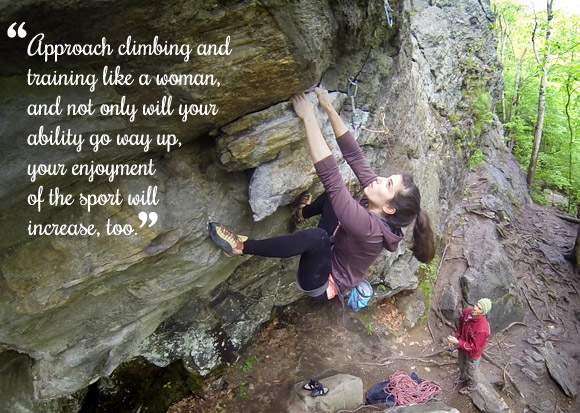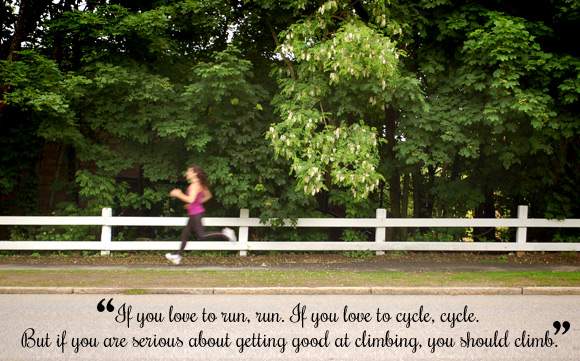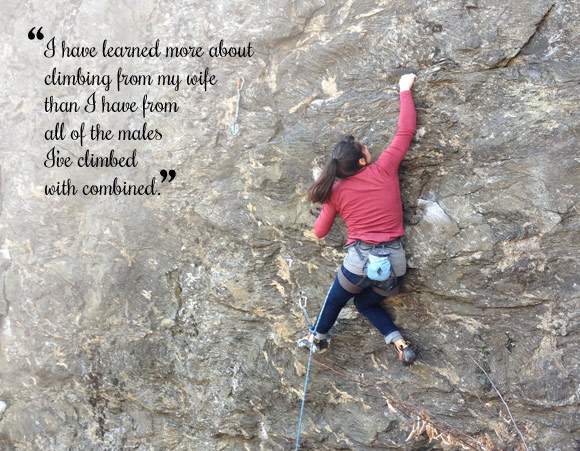Today’s post was written specifically for our site by nutrition expert, performance coach, and personal trainer, Steve Bechtel. Long before the inception of Crux Crush, we were reaping the benefits of Steve’s articles and training advice on Climb Strong, and today we’re very excited to share his words of wisdom on three training myths for female climbers, specifically for females. Here’s what he had to say:
Climbing is hard and training for climbing is even harder. Here’s the thing that really sucks – both of these things can be even harder if you’re a girl. Note that I said “can” be even harder. If you approach training the way that a guy does, you might be in trouble. Approach climbing and training like a woman, and not only will your ability go way up, your enjoyment of the sport will increase, too.

Find the truth of rest days here!!!
Earlier this year, I started talking to the girls at Crux Crush about the primary concerns and challenges out there for female climbers today. We nailed down six areas where training and climbing were fundamentally different for women and men. This article outlines three of those areas and the ways to avoid getting trapped by conventional thinking or male-dominated tactics. The other three are discussed in Part 2: 3 Training Questions All Climbers Should Ask.

Training Myths For Female Climbers #1: Strength Training is Bad
There is a widely-held perception that resistance training leads to unwanted bulk and “useless” muscle. This perception is perpetuated by photos of female bodybuilders and their, uh…strange beauty. The behavior of these females, both in training volume and pharmaceutical supplementation, is worlds away from a strength-based training program for climbers.
A woman looking to gain strength for rock climbing would be well-served to gain some total body strength in the weight room. Women have far lower levels of muscle-building hormones than men do, so in order to gain strength (without the bulk), they need more frequent, very intense sessions. Lifting heavy (5 rep max or heavier) takes a while to get used to, but the benefits are big. You’ll overload primarily the nervous system, increasing muscle “recruitment” rather than building size. That way, you can stay lean but get way stronger – which equals the foundation you’ll need for hard sends.

Look to do total body movements or big-bang exercises such as pull-ups, deadlifts, and heavy presses. You’ll want to do 3-5 reps of the strength movements, for 2-3 sets per workout. Make sure you’re not working to total failure, but instead going only as hard as you can with perfect form. The best part is this: you can get really strong in just 2-3 30-minute sessions per week. I like to have my athletes integrate this with bouldering days, and then follow up with a full day of rest.
Training Myths For Female Climbers #2: Aerobic Training is Good
Running is a great sport if you’re into running. It’s not so good as supplemental training for climbing. The aerobic fitness built by running is different than that required by climbing; there is a very little metabolic or motoric crossover (meaning the energy used and the moves you make are too different to benefit from climbing). To get better at climbing, you need to climb or train with similar loads and durations. If you run to lose weight, well…
Somehow, sometime, someone decided that running was good for fat loss. Now, before you write me off as a weightlifting meathead, understand that I like running and cycling and skate skiing more than I like lifting weights. There are two things I won’t tolerate, however. The first is a training program that doesn’t deliver the promised results. The second is a training program that is going to hurt the athlete.
A person that is overweight and is not already a runner that starts a running program is breaking both of these rules. It’s like the old runners’ joke “Are you training right now or are you injured?” Running is exceedingly punishing to the joints. Some people can handle running, others can’t. The fat-loss benefits are minimal, and science is pretty solid behind intervals and strength training for fat loss.

Steady-paced cardiovascular training is fine for fitness and is fun to do. For fat loss, though, it just doesn’t deliver the goods. See, when you exercise to lose weight, the calories burned by the activity are pretty minimal. If you do some weight training or intervals, there is a “metabolic effect” that causes you to continue to burn calories for hours (one study claimed as much as 38 hours) after the training session. Another interval-style activity that meets the same training profile: is rock climbing.
Again, if you love to run, run. If you love to cycle, cycle. But if you are serious about getting good at climbing, you should climb.
Training Myths For Female Climbers #3: All You Need is Good Technique
I have learned more about climbing from my wife than I have from all of the males I’ve climbed with combined. When I watch her easily do sequences I had previously thugged my way through, I make it a point to go back and try it the way she did it. Despite our height and strength differences, I almost always find her beta to be the better.
Most guys are pretty strong when they start climbing. They tend to apply brute force to their movements rather than trying to find the most efficient way to do it. Only after many months of climbing does good technique start to show. On the other hand, many women come to climbing with a relatively weak upper body, which I claim is a huge benefit down the road. A weaker climber is forced to use good body position and footwork to make it up routes. Since strength is not a default fall-back, good climbing form is accelerated.
Be that as it may, technique alone is not enough to make a strong climber. Lucky for women, strength is much simpler to develop than good technique. With a regular bouldering routine of 2-3 sessions per week plus some strength training in the weight room, you can go from weak to pretty damn strong in a year or less.
We hope this article helps to keep your training on track. Thank you very much to Steve Bechtel for contributing to Crux Crush! For Steve’s thoughts on 3 more training topics check out 3 Training Questions All Climbers Should Ask. And don’t forget to visit climbstong.com for great articles and training advice.
More On The Man Behind The Myths
Steve Bechtel is a nutrition expert, performance coach, and personal trainer. He graduated from the University of Wyoming in 1995 with a degree in Exercise Physiology. He has been working with athletes of all levels for over fifteen years and is a sought-after expert in training for rock climbing and alpinism. He is a Certified Strength and Conditioning Specialist (CSCS) and is a certified coach with USA Cycling, USA Weightlifting, Kettlebell Athletics, and USA Triathlon. Steve is also a well-known adventure rock climber.
Over the past 27 years, he has made nearly 300 first ascents on 6 continents and has been to the top of some of the world’s hardest big wall-free climbs. The founder of Climb Strong, a training resource for rock climbers, Steve has authored dozens of articles on training and has published three books. He is the co-founder (with his wife, Ellen) of Elemental Performance + Fitness, a full-service training center and climbing gym in Lander, Wyoming.






